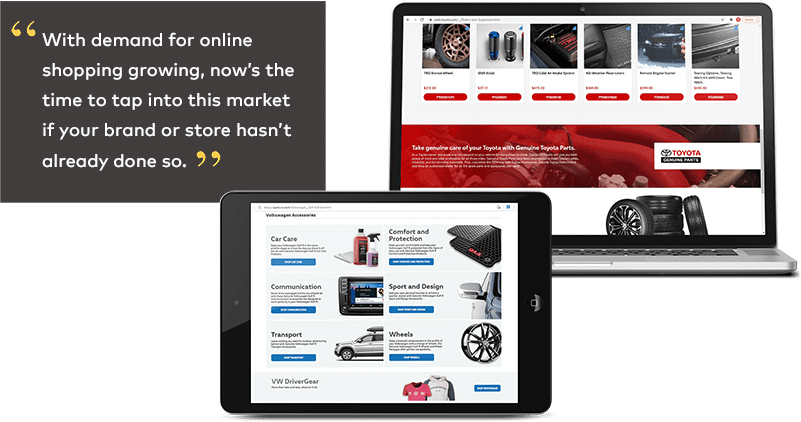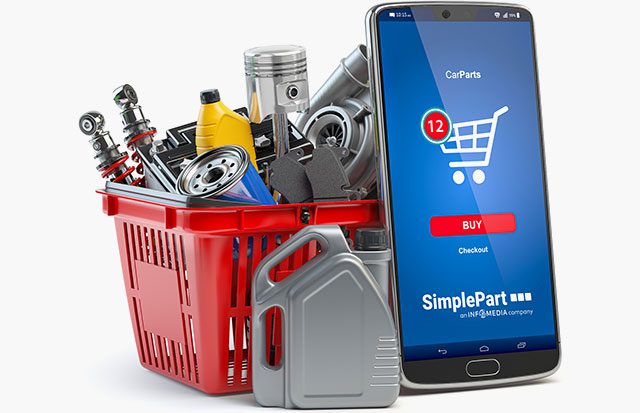The automotive aftersales industry is adapting to the online boom
Besides a general shift towards online shopping by all of us – a move driven by ease, choice and convenience – there are a range of factors that have led to the rise in automotive aftersales online sales in particular. These include:
- An increase in average vehicle age. People are keeping their cars for longer and opting to replace parts instead of replacing their entire vehicle.
- An increase in vehicle use. This creates more wear and tear on a vehicle, increasing the demand for aftersales products.
- A booming used car market. More people are buying used vehicles than ever before, which increases the need for aftersales products sooner than with new vehicles.
The bottom line? With demand for online shopping growing, now’s the time to tap into this market if your brand or store hasn’t already done so.
Online retail is helping OEMs and dealerships win back market share from the aftermarket
When the aftermarket sector started to take proper advantage of the early e-commerce boom, OEMs and dealers began losing market share to them. Over the past 10 years however, more OEMs have begun to realize that they can offer their customers a high-quality shopping experience that will help increase brand engagement, while also taking advantage of the ease that shopping online affords customers. As well as winning back lost market share and reconnecting owners with the brand, it also helps local dealers re-engage with vehicle owners, even if that is just digitally.
The e-commerce market continues to grow globally
According to this survey backed by the United Nations, there was a marked increase in general retail sales via e-commerce – from 16% to 19% – in 2020, with the most notable rises occurring in Australia, Canada, China and Korea. But e-commerce is on the rise everywhere, not just in isolated territories. It is vital brands tap into the global e-commerce market and take advantage of its growth.

Online shopping platforms are influencing customer expectations, taking market share from brick-and-mortar shops
As a result of the global pandemic, people have increasingly begun using online marketplaces in new ways. Purchasing groceries online has been a feature of many consumers’ lives for years, but inevitably, more people began buying new vehicles and parts online over lockdown. E-commerce usage in the U.S. surged a whopping 44% in 2020. This trend was even more pronounced in the automotive aftersales space, which, according to a Carlisle & Company Custom Study, produced an average of 131% growth year-over-year on OEM platforms. Such results are encouraging, but a recent survey showed that customers still buy parts online more frequently from other retailers – companies such as AutoZone, Amazon, Supercheap Auto and Bursons – than they do from the OEM websites.
Amazon
No one benefited from e-commerce’s growth over the past year more than Amazon. According to Hedges & Company, Amazon’s auto parts market share is the largest in the world. In 2020 alone, Amazon sold US$8.3bn worth of parts and accessories, plus US$1.9bn in OEM replacement parts sales. Orders directly fulfilled by Amazon (FBA) represented US$4.6bn.
eBay
It’s estimated that eBay Motors’ revenue was about US$11bn in 2020, making it a huge player in the parts and accessories sales market. Of that revenue, about US$8bn came from resellers exclusive to eBay, while about US$3bn was from resellers that also sell on their own websites and/or Amazon.
While e-commerce accounts for a relatively small slice of parts and accessories sales for OEMs, consumers are increasingly expecting an “endless aisle experience”, low prices and the convenience of online shopping, often on mobile. This, coupled with the instant gratification that you get from same day delivery by Amazon, makes it increasingly important for OEMs to invest in e-commerce and “hybrid” solutions (online plus brick and mortar) to meet the needs of modern vehicle owners.

Why should OEMs and dealers have an online presence?
There is a huge opportunity for OEMs and their networks of dealerships to grow their online business. When it comes to e-commerce, the automotive industry is still extremely under-represented (5% of sales are online), compared with other industries like furniture (19%) and apparel (30%).
Even if you aren’t online yet, your customers almost certainly are. Nine out of ten consumers research their online options before they purchase an automotive part or accessory (Hedges & Company). And SimplePart has found that of online customers who enter a vehicle identification number (VIN), 46% are second and third owners who have yet to go to a dealership for a service, and so are new to the OEM’s vehicle-owner database.
What does this all mean?
That customers are likely to know about your dealership’s products even before they step foot in your dealership. It also means that your online presence is often the first impression that your dealership gives to consumers. What’s more, it can play a significant role in winning back owners that have been lost, not just to the aftermarket sector, but in the service and vehicle sales markets as well.
If your goal is to increase sales by getting closer to your customers, the answer is clear. Whether it be in parts, service or vehicle sales, you need to get your store online.




